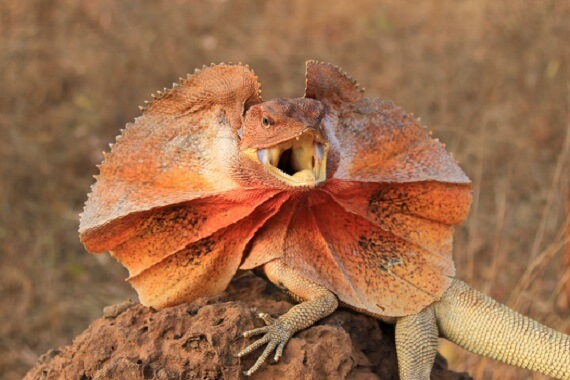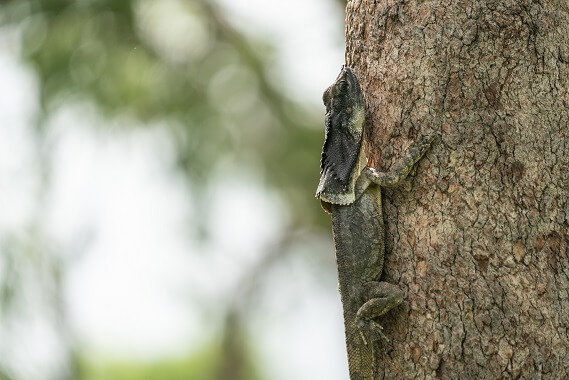
The frilled lizard (Chlamydosaurus kingii) – also known as the frill-necked lizard or the frilled dragon – is a large, tree-dwelling lizard that is found in Northern Australia and Papua New Guinea. It is the second-largest lizard in the family Agamidae. These lizards grow to a maximum of 3 feet (90 cm), two-thirds of which is made up of their long tail. They are brown or grey in color. This lizard gets its name from the frill around its neck, which it can extend when it feels threatened. The frill is lighter in color than its body and can also have orange, yellow, and red patterns on it. Frilled lizards are most likely to be found in forested areas and are arboreal – meaning that they prefer to spend most of their time in trees – only coming down to the ground in search of food. These lizards are omnivores and will eat anything they can. However, they prefer to feed on insects, spiders, and other invertebrates and will sometimes also eat other lizards and small mammals. These lizards have a long tail and sharp claws, which make it well adapted for life in the trees. Male frilled lizards are larger than females. Frilled lizards reproduce at the start of the wet season. The female will lay her eggs in a burrow in the ground and then bury them. The eggs hatch after a few months, and the hatchlings are fully independent. These lizards have few natural predators. Large snakes, owls, and dingos are the most common predators. Foxes and birds of prey also pose a threat. Hatchlings and juveniles are most at risk from predation. The frilled lizard is also known as the bicycle lizard because of the way it can move on two feet. It also has an intimidating frill to scare off its predators, which it erects when it feels threatened before running away. These are just some examples of the amazing adaptations that this lizard has, and they are great examples of biological concepts. Let’s investigate further. Frilled lizards are named after the frill around their necks. This frill can be erected when they feel under threat, when they are marking their territory or when they are trying to attract a mate. When predators or rivals are spotted, the frill is erected to act as a warning and intimidate the animal posing a threat by making the lizard appear much bigger and scarier than it is. The frill itself is a large, colorful, circular membrane of skin that projects both upwards and outwards from the lizard’s neck. It is supported by spines that connect to the lizard’s jawbones. The frill can be up to 12 inches (30 cm) in diameter when it is fully erect. Aside from displaying its frill, this lizard will also stand up on two legs, open its mouth wide and let out a loud hiss to try and frighten its predators away. Many animals will make themselves appear larger to warn off approaching predators. Great Horned owls, for example, will fluff out their feathers so that they seem a lot larger than they really are. Perhaps the most famous example is the cobra, which will extend out its hood when it is excited to warn predators that it is a threat. Most lizards are quadrupedal – which means they move on four legs. Frilled lizards, however, are well known for their bipedal locomotion and will rear up on two legs when they feel threatened. This enables them to move much more quickly and reach the safety of the trees faster than they would on four legs. Researchers think that these lizards do this as it helps them to accelerate faster. This movement is related to the lizard’s center of gravity. The center of gravity is much lower in these lizard’s bodies than other lizards that move primarily on four legs. This lower center of gravity causes their front legs to lift off the ground as they accelerate. This is an important adaptation that enables them to move away from danger much more quickly than if they had to move on four legs. The sex of a frilled lizard’s offspring is decided by the incubation temperature of the eggs during a specific temperature-sensitive period during the development of the eggs. Biologists call this phenomenon temperature-dependent sex determination. If the eggs are incubated at 78.8 degrees Fahrenheit (26 degrees Celsius), the offspring are most likely to be female. However, if the eggs are incubated at 84.2 degrees Fahrenheit (29 degrees Celsius), then it is likely that there will be an equal number of male and female hatchlings. Temperature-dependent sex determination is unique to several reptile and teleost fish species. This non-genetic mode of sex determination is present in all species of crocodile, most turtles, some species of teleost fish, and some reptiles.
Kingdom
Animalia
Phylum
Chordata
Class
Reptilia
Order
Squamata
Family
Agamidae
Genus
Chlamydosaurus
Species
Chlamydosaurus kingii
Length
Maximum length is 3 ft (90 cm)
Weight
1.1 – 2.2 pounds (0.5 – 1 kg)
Lifespan
Up to 20 years in the wild
Social Structure
Solitary
Statu
Least Concern
Preferred Habitat
Evergreen forests
Average Clutch Size
8 – 23 eggs
Main food item
Ants, small lizards, cicadas, spiders, termites, and small mammals
Main predators
Birds of prey, larger lizards, snakes, dingoes, and feral cats.
The Basics

Fun Facts about the Frilled Lizard!
Intimidating Frill

Bipedal Locomotion

Nest Temperature Decides the Offsprings Sex
